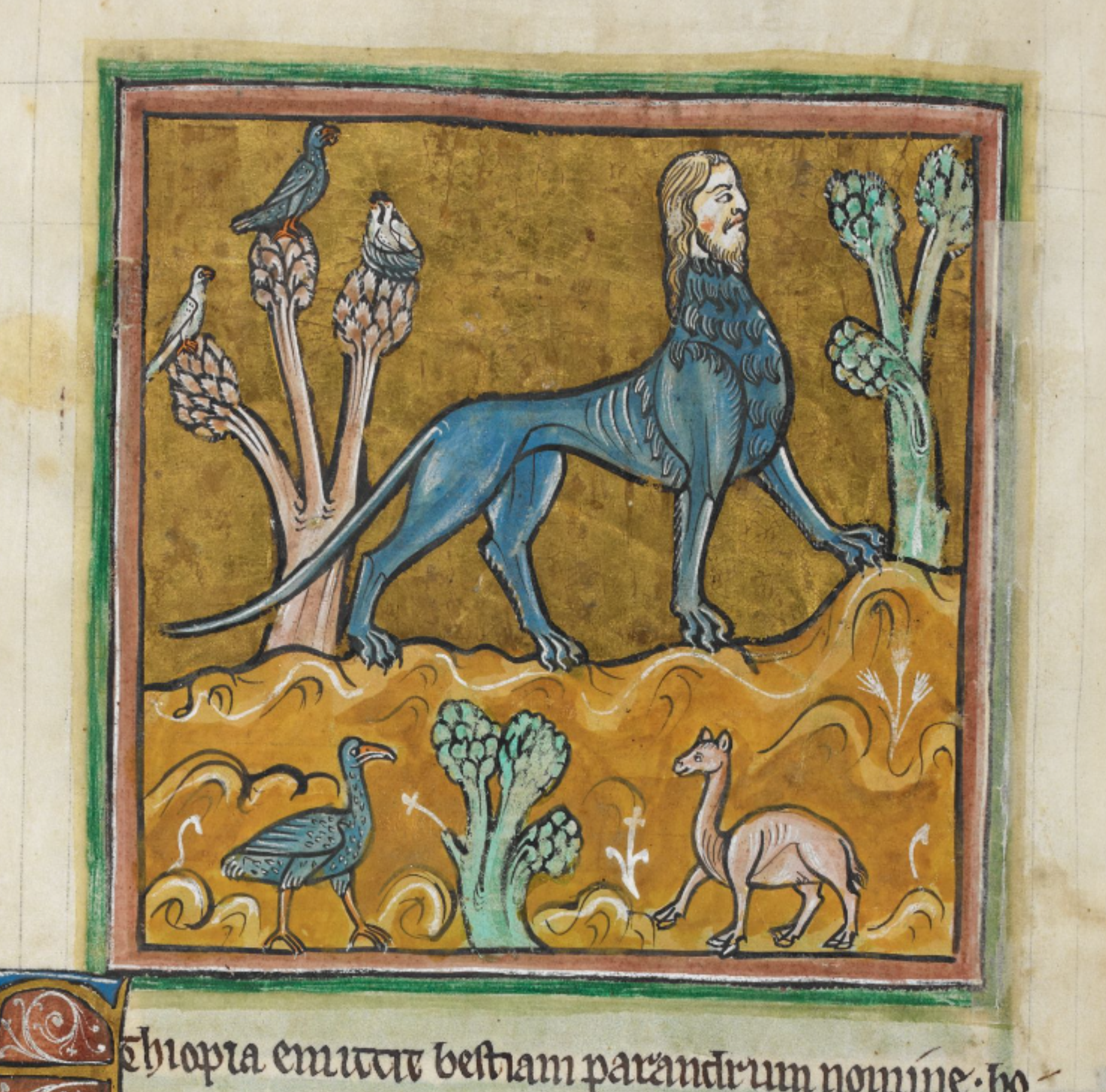Manticore, Rochester Bestiary, c.1230
The manticore was the cruellest and most bloodthirsty animal of all beasts, owing to its longing for human flesh.
This beast has a leonine body, a human face and a tail resembling a scorpion’s sting and its origin is to be traced back to India or Persia. Its name comes from the Persian mardkhora, which means man-eater.
In Gustave Flaubert’s The Temptation of St Anthony, the manticore says of itself:
“The gleam of my scarlet hair mingles with the reflection of the great sands. I breathe through my nostrils the terror of solitudes. I spit forth plague. I devour armies when they venture into the desert. My claws are twisted like screws, my teeth shaped like saws, and my curving tail bristles with darts, that I broadcast right and left, before and behind.”
In Christian symbolism, this animal was associated with the prophet Jeremiah because he was buried beneath the ground whilst there were rumours that a manticore was living in a cave, but this association short-lived.
The manticore represented envy, tyranny and the embodiment of evil but also sinful desires: its insatiable appetite for human flesh could be interpreted as a symbol of sinful desires and the dangers of giving in to hedonistic or immoral behaviour. This allegory emphasized the importance of resisting such temptations.
The manticore's hybrid nature, combining features of different creatures, was sometimes seen as a symbol of moral confusion or lack of a clear moral foundation. It served as a cautionary tale about the consequences of straying from virtuous paths.
hominis. glaucis oculis. sanguineo colore. corpore-
leonino. cauda velut scorpionis aculeo. spiculata
voce tanquam sibila ut imitetur modulos fistularum.
humanas carnes avidissime affectat. pedibus sic viget;
saltibus sic potest. ut mori eam nec extensissima1 spa-
cia possint cogere; nec obstacula latissima;
The manticore2 is a beast born in India. It has three rows of teeth that intertwine like the teeth of a comb. It has the face of a human, greyish-blue eyes and a blood-red colour. It has a leonine body, and its tail resembles a scorpion's sting. It has a sharp, hissing voice similar to the sound of flutes and bagpipes. It eagerly longs for human flesh. It is so swift and jumps so high that neither the vastest areas nor the most insuperable obstacles can force it to die.
Bibliography
David Badke, The Bestiary Blog: Animals in the Middle Ages, Crocodile, November 6 2023, https://bestiary.ca/beasts/beast146.htm
Josh Goldenberg (BA 2012) and Matt Shanahan (BA 2014), Logeion, November 2022, https://logeion.uchicago.edu/
Castiglioni, L. and Mariotti, S. (1996). Vocabolario della Lingua Latina: Latino-Italiano Italiano-Latino. Terza Edizione. Loescher Torino
Matthews, J. and Matthews C., (2010), The Element Encyclopedia of Magical Creatures, HarperCollins UK, London
Curley, M. J., Physiologus: A Medieval Book of Nature Lore (University of Chicago edition 2009)
Rackham, H., M.A., Pliny Natural History Volume III, Libri VIII-XI (London: William Heinemann Ltd, 1949)
Collins, A. H., M.A., Symbolism of Animals and Birds (New York: McBride, Nast & Company, 1913)
Henderson, C., The Book of Barely Imagined Beings (London: University of Chicago Press, 2013)
White, T. H., The Bestiary: A Book of Beasts (New York: G.P Putnam’s Sons, 1960)
Barney, S. A., Lewis, W. J., Beach A., Berghof O., The Etymologies of Isidore of Seville (New York: Cambridge University Press, 2006)
Footnotes
1 Extentus/extensus
2 The Latin spelling is mantĭchōrās and comes from the Greek μαρτιχόρας/martikhórās.

